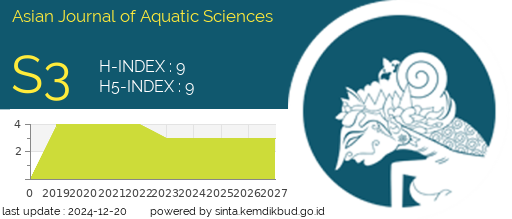IDENTIFICATION OF LACTIC ACID BACTERIA (BAL) FROM THE INTESTINES OF Pangasianodon hypophthalmus THAT WAS FEEDED BY FERMENTED HERBAL AND THE ABILITY TO INHIBIT Aeromonas hydrophila BACTERIA
DOI:
https://doi.org/10.31258/Keywords:
Striped catfish, antimicrobial, Fermented herbal, BALAbstract
Lactic acid bacteria can improve digestibility because they can be absorbed directly by the body. The purpose of this research was to obtain lactic acid bacteria types from the intestines of striped catfish (Pangasionodon hypophthalmus) that had been fed fermented herbal feed. This research was conducted from June 2019 to April 2020. The treatment used in this research was with different doses and stocking densities. The test was carried out using the disc diffusion method or the Kirby-Bauer method, which was done by measuring the inhibition zone around the paper disc. Identification of LAB was carried out by phenotypic and genotypic. The results showed that as many as four of the selected isolates were able to inhibit the growth activity of the pathogenic bacteria Aeromonas hydrophila. Isolates with code K had an inhibition zone of 6.7 mm against A.hydrophila, an inhibition zone of 7.5 mm for P1D2 isolates, P2D1 isolates had an inhibition zone of 7.0 mm, P2D2 isolates had an inhibition zone of 7.8 mm. Types of LAB that were identified phenotypically and genotypically include Lactobacillus casei, L.plantarum, and L. acidhopilus
Downloads
References
1. Wardono, B., Adhita, S. (2016). Analisis Usaha Pakan Ikan Mandiri di Kabupaten Gunungkidul. Jurnal Kebijakan Sosek KP. 6(1): 75-85.
2. Fadri, S., Muchlisin, A.Z., Sugito, S. (2016). Pertumbuhan, Kelangsungan Hidup dan Daya Cerna Pakan Ikan Nila (Oreochromis niloticus) yang Mengandung Tepung Daun Jalan (Salix tetrasperma Roxb) dengan Penambahan Probiotik EM-4. Jurnal Ilmiah Mahasiswa Kelautan dan Perikanan Unsyiah. 1(2): 210-221
3. Sumaryati, S., Urnemi., Purwati, E., Ibrahim, S., Jamsari. (2011). Potensi Bakteri Asam Laktat dalam Menghasilkan Bakteriosin Sebagai Antimikroba dan Pengukuran Berat Molekulnya dengan SDS-PAGE dari Isolat Fermentasi Kakao. Jurnal Riset Kimia. 4(2).
4. Delfahedah., Syukur, Y., Jamsari, S. (2013). Isolasi Karakterisasi dan Identifikasi DNA Bakteri Asam Laktat (BAL) yang Berpotensi Sebagai Antimikroba dari Fermentasi Kakao Varietas Hibrid (Trinitario). Jurnal Kimia Unand. 2(4).
5. Heni, M. (2013). Isolasi dan Karakterisasi Bakteri Probiotik dari Saluran Pencernaan Ayam Kampung (Gallus domesticus). Fakultas Matematika dan Ilmu Pengetahuan Alam. Universitas Hasanuddin.
6. Hasanah, U. (2014). Bakteri Asam Laktat dari Daging Ikan Peda Sebagai Agen Probiotik dan Enzim Kolesterol Reduktase. Jurnal Keluarga Sehat Sejahtera. 12(23):1-8.
7. Situmeang, S.M.F., Musthari. Riadi, S. (2017). Isolasi dan Uji Aktivitas Antimikroba Bakteri Asam Laktat (BAL) dari Yoghurt dalam Menghambat Pertumbuhan Bakteri Escherichia coli dan Salmonella typhi. Jurnal Biosains. 3(3):144-152
8. Tamura, K., G. Stecher, D. Peterson, A. Filipski, S. Kumar. 2013. MEGA6: Molecular Evolutionary Genetics Analysis Version 6.0. Molecular Biology and Evolution, 30 (12): 2725-2729
9. Tallei, T.E., Rembet, R.E., Pelealu, J.J., Kolondam, B.J. (2016). Sequence Variation and Phylogenetic Analysis of Sansevieria trifasciata (Asparagaceae). Bioscience Research13(1): 01-07
10. Dharyamanti. (2011). Filogenetika Molekuler: Metode Taksonomi Organisme Berdasarkan Sejarah Evolusi. Wartazoa 1(21): 1-10.
11. Kumar, A.M., Mururgalatha, N. (2012). Isolation of Lactobacillus plantarum from cow milk and screening for the Presence of Sugar Alcohol Producing Gene. Journal of Microbiology and Antimicrobial. 4(1): 16-22.







